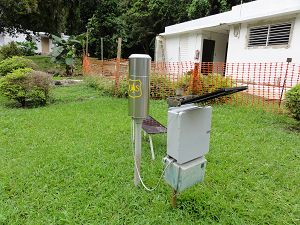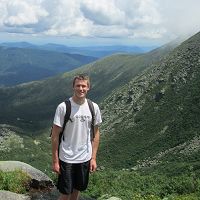Climate Research Group
The Luquillo Critical Zone Observatory is located in the windward, Northeastern portion of Puerto Rico and in one of the wettest regions of the Caribbean. Over a distance of 10 to 20 km, this mountain range rises from sea level to an elevation of 1075 meters. The Observatory has a subtropical, humid, maritime climate that is influenced by both orographic and global-scale synoptic weather systems. Rainfall is relatively evenly distributed throughout the year and increases from 1000 mm/yr in the lowlands to nearly 5000 mm/yr at the highest elevations. Rainfall events at mid-elevations are generally small (median daily rainfall 3 mm/day) but numerous (267 rain days per year) and of relatively low intensity (< 5mm/hr). Nevertheless, individual storms with greater than 125 mm/day occur annually, and daily rainfalls greater than 600 mm have been recorded.
Image: Ott rain gage at Sabana field station. Photo: Miguel Leon May 2010.
This group is tagged with:
-
The most common disturbance-generating weather systems that affect the Luquillo Mountains are (1) cyclonic systems, (2) noncyclonic intertropical systems, (3) extratropical frontal systems, and (4) large- scale, coupled ocean-atmospheric events (e.g., North Atlantic Oscillation, El Niño-Southern Oscillation). Unlike some tropical forests, the Luquillo Mountains do not commonly have disturbances associated with the passage of the Inter-Tropical Convergence Zone (ITCZ) or monsoonal rains.
The focal climatic questions being addressed by the Luquillo Critical Zone Observatory concern how atmospheric inputs (e.g. rainfall, cloud water inputs, nutrients, dust etc.) vary spatially and temporally across the Luquillo Mountains. Research facilities include a series of weather stations, above canopy towers, and long-term records of climate and rainfall chemistry.
See Luquillo Meterological Stations for the Mameyes and Blanco
See Temperature and Rainfall models for Northeast Puerto Rico based on elevation Here
-
Contacts
-
Luquillo, INVESTIGATOR
-
Luquillo, INVESTIGATOR
4 People
INVESTIGATOR, Lead-PI
.(JavaScript must be enabled to view this email address)
biogeochemistry, Hydrology
UNDERGRAD
.(JavaScript must be enabled to view this email address)
---
GRAD STUDENT
.(JavaScript must be enabled to view this email address)
---
Alumni-Former
GRAD STUDENT
Canopy level ozone in this montane tropical rainforest
.(JavaScript must be enabled to view this email address)
Field Technician, Biogeochemistry
-
-
Featured Publications
2011
Wet canopy evaporation from a Puerto Rican lower montane rain forest: the importance of realistically estimated aerodynamic conductance. Holwerda F., Bruijnzeel L.A., Scatena F.N., Vugts H.F., Meesters A.G.C.A (2011): Journal of Hydrology 414, 1-15.
2007
Disturbance and long-term patterns of rainfall and throughfall nutrient fluxes in a subtropical forest in Puerto Rico. Heartsill-Scalley, T., Scatena, F.N., Estrada, C., McDowell, W.H., Lugo, A.E. (2007): Journal of Hydrology, 33:472-485
2006
Characteristics of fog and fogwater fluxes in a Puerto Rican elfin cloud forest. Eugester, W., Burkard, R., Holwerda, F., Scatena, F.N., Bruijnzeel, L.A., (2006): Agricultural and Forest Meterology
Explore Further




